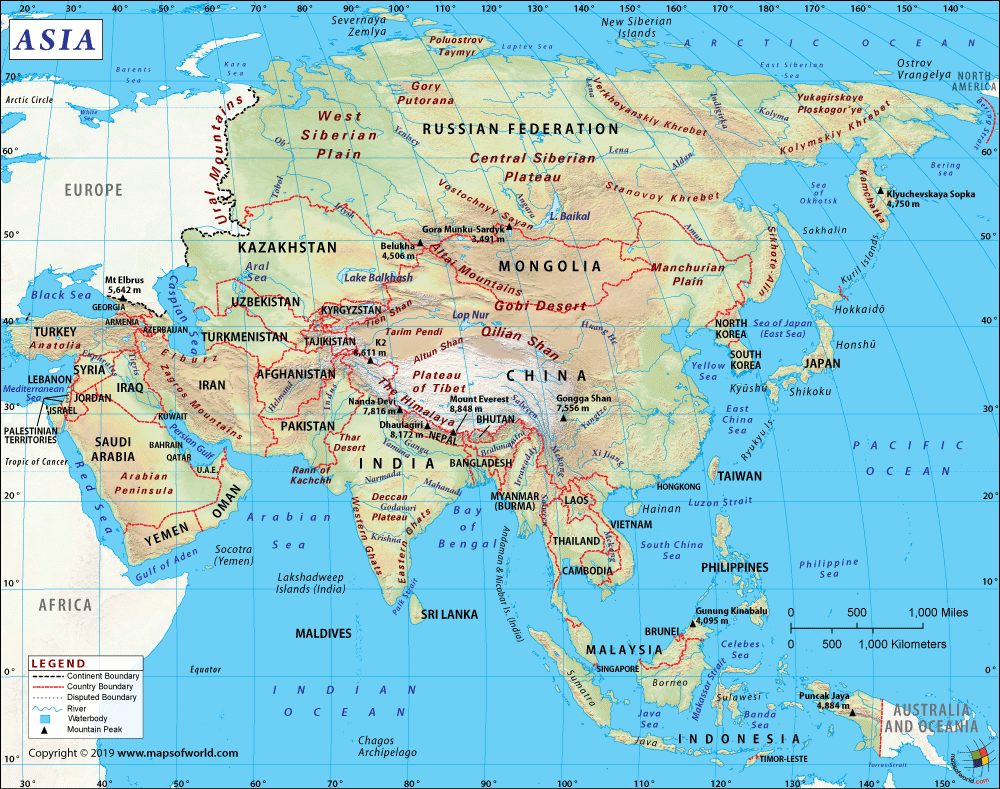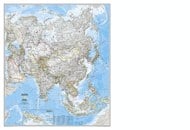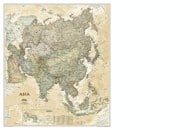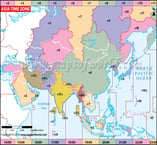Asia Map
Map of Asia shows all the countries of Asia on a high quality map and you can click on any country for its map and information. Asia is the largest, both in terms of area and population. Europe and Africa are located to the West of Asia. Oceania is situated to its South and North America to its East. Asia consists of 48 countries. Because Asia's borders are not finite, some countries that are located on the continent's western border are, sometimes included in Asia, and other times in Europe. These include Armenia, Azerbaijan, and Georgia. Russia and Turkey are located in both Europe and Asia. The continent comprises diverse climatic conditions ranging from tropical in southern India and Southeast Asia, to arctic and sub-arctic in Siberia.
Map of Asia - Click on any Country for its Map and Information
| Disclaimer |
-

Asia Classic Map
$16.95
-

Asia Executive Map
$16.95
-

Asia Physical Map
$18.99
×
Disclaimer : All efforts have been made to make this image accurate. However MapSherpa, Inc, its directors and employees do not own any responsibility for the correctness or authenticity of the same.
Asia Map Description: This map of Asia shows the clear demarcation of the nations of the continent. Disputed boundaries are also shown on the map. The map is a physical view of the major landforms in the continent, such as the Himalayas, the Siberian plain, the Gobi Desert, the Manchurian Plain, the Arabian Peninsula, the Central Siberian Plateau, Zagras Mountains, the Qilian Shan, and the many islands in the south. This map also notes the highest peaks present on the continent, such as Gongga Shan, Belukha, Mt Everest, K2, Gora Elbrus, Klyuchevskaya Sopka, Dhaulagiri, and Nanda Devi.
About Asia
Asia is the largest continent in the world, both in size and population. It has an area of 17,212,000 sq. miles, and population of 4.5 billion as of September 2018 estimates. Asia consists a total of 49 UN member countries, with China and India being the largest economies. Some of the other countries are: Myanmar, Kazakhstan, Cambodia, Pakistan, North Korea, South Korea, Japan, Philippines, Thailand, Taiwan, Vietnam, Singapore, Malaysia, Indonesia, Bangladesh, Bhutan, Nepal, Sri Lanka, Afghanistan, Turkmenistan, Tajikistan, Mongolia, Uzbekistan, Kyrgyzstan, and the Middle Eastern Nations. Russia and Turkey are two countries that span across both Asia and Europe. Principal languages spoken here are Chinese, Bengali, Hindi, Punjabi, Javanese, Japanese, Korean, and Urdu. The major religions followed by the people are; Hinduism, Islam, Buddhism, Christianity, Judaism, Shintoism, Zoroastrianism, Sikhism, and Taoism. To explore more about the continents, check out our Continents Map.Other Continent Maps - World Continents Map, Map of Europe, Map of Africa, Map of South America, Map of North America, Map of Oceania, Map of Antarctica
Countries in Asia
Asia is home to 49 countries, each offering its own distinctive culture, landscapes, and history. For the individual map of each country, click on the country name in the below table.
History of Asia
There are two theories surrounding the origin of the word “Asia”. One considers it to be the derivative of an Ancient Greek word, "Aơiα", which was first associated to the Persian Wars in 440 BC. But, initially, it was thought to refer to the east bank of the Aegean Sea - the area which was famous for being related to Hittites as "Assuwa." Another idea is that the word Asia is derived from the word "Asu," which means "rising," or "light," referring to the sunrise. Loosely translated, Asia means the "Eastern Land," from which the sun rises.Asia has been home to numerous first civilizations of the world. In fact, civilizations that inhabited the Indus Valley, Mesopotamia, and the Yellow River had many similarities. The diverse population of Asia is an evidence of the numerous religions that were born here.
Asia has been under the rule of various kings during different eras. History has recorded that a wise king, Chandra Gupta Maurya, a former slave, became the founder of the Maurya Dynasty. Maurya died in 297 BCE, after becoming known in the Hellenistic world for defeating Seleucus I Nicator. Another famous and well-loved king of those times was King Ashoka, the grandchild of Chandra Gupta Maurya, who died in 232 BCE. Another golden era in the history of Asia was the era of Muslim rulers, from 632 AD until the Ottoman Empire's reign in 1566. The Russian Empire expanded in the continent in 17th century and had Serbia, and most of Central Asia in its control. Much of India was under the reign of Islamic Mughal Empire and the Hindu Maratha Empire between 16th and 18th century. Many of the Asian rulers built elaborate monuments during their reign, considered masterpieces and visited by millions of people to this day.
Black death, popularly referred to as Great Plague, was one of the most ghastly epidemic diseases to have occurred in human history. It is believed to have originated in 1346 in the dry plains of Central Asia. It, however, had spread to Europe via Silk Route, and an estimated 75 to 200 million people died in Eurasia.
Culture and People of Asia
Asians are best known for their attractive features and the simplicity in their ways of living. In the Asian cultures, having guests is considered an honor, and they are treated with great respect - so generally, they are observed to be openhearted and generous towards their guests.The diverse ethnic groups have maintained their love for their culture, art, music, literature, religion and philosophy.
Geography of Asia
The huge landmass of Asia covers 30% of the total landmass on Earth, and has the largest coastline, stretching 39,022 square miles. The continent includes numerous rivers, lakes, mountains, deserts, and other physical features. Asia, It is surrounded by three oceans – Pacific Ocean, Arctic Ocean, and the Indian Ocean.The Himalayan Range belongs to Asia, and is home to the earth's highest mountain – Mount Everest (29,029 ft). There are more than 50 mountains that reach an elevation of 23,600 ft. The Himalayas, expand 1,500 miles, spreading over five countries – India, Bhutan, Nepal, China, and Pakistan. It divides the Indian subcontinent from Tibetan Plateau. Some major rivers that rise from here are the Ganges, Indus, and Tsangpo-Brahmaputra. Apart from Mount Everest, other major mountains in Asia are K2, Kangchenjunga, Mount Carmel, Mount Kailash, Nanda Devi, etc. About15,000 glaciers and numerous freshwater sources exist in Himalayas. Other mountain ranges in the continent are Pamir Mountains, Hindu Kush, Caucasus Mountains, and more.
Some of the world's largest deserts are located in Asia. These include the Gobi desert in Central Asia and the Arabian & Syrian Deserts in West Asia. The Arabian Peninsula is dominated by the Arabian Desert, that is spread over 899618 sq. miles. The main natural resources found in this desert are natural gas, phosphates, sulfur, and oil.
Some of the longest rivers in the world are a part of Asia, with the longest being Yangtze. It has a length of 3,915 miles. The Ganges, Brahmaputra, and Indus are other noteworthy rivers. The Caspian Sea is surrounded by Iran, Russia, Kazakhstan, Azerbaijan, and Turkmenistan and is considered the largest lake on the planet. It has no outflows and covers an area of 143,243 sq. miles. Lake Baikal is the world's deepest lake. Situated in the southern part of Russia, it reaches a depth of 5,387 ft.
Plateaus that exist in Asia are:
- The Iranian plateau, which encompasses the countries of Afghanistan, Pakistan, and Iran. It covers an area of 1.4 million square miles.
- The Deccan Plateau which has an elevation of 600 meters, and comprises most of South India.
- Tibetan Plateau which is popularly known as the Rooftop of the World.
The largest countries in Asia are Russia, China, India, and Kazakhstan. The smallest are Maldives, Singapore, Bahrain, and Brunei.
The estimated area encompassed by Asia is 44,000,000 sq. km, making it the biggest continent on the planet. Consequently, the geography varies across the continent. Nature wonders like Gobi desert and the towering snow-capped peaks of the Himalayas are just a few of the gems. Rivers and lakes are also aplenty. Asia is not sharply divided by Europe. It is only an imaginary line that marks the boundary, connecting the Ural Mountains, Ural River, Caspian Sea, and the Caucasus Mountains.
Tourism in Asia
Asia has a plenty of world-renowned monuments that can give anybody a glimpse back into history. Snow-capped mountains, meandering rivers, never-ending deserts, and sparkling lakes, are just the part of the prelude to the boundless beauty of Asia.
Some of the top tourist destinations in the continent are the Great Wall of China, Burj Al Arab, Taj Mahal, Petronas Twin Towers, and more. The tallest statue – Statue of Unity, has been built in India, that reaches a height of 597 ft.
Hong Kong, India, Philippines, China, Thailand, and Japan – are visited by millions of tourists annually.
Facts about Asia
- It is the largest continent in the world.
- Asia is the name of Titan Goddess of Lydia in Greek mythology.
- It is the most populous continent on the planet.
- It is bounded by 3 oceans: Pacific Ocean, Indian Ocean, and the Arctic Ocean.
- It is the birthplace of some of the oldest civilizations.
- It has both the highest peak (Mt. Everest) and the lowest peak (the Dead Sea)
- Bangkok, the capital of Thailand, is the most visited city in the world.
| Asia Geography Facts |
|---|
| Largest Urban Area | Tokyo-Yokohama, Japan (37.8 million people) |
| Highest Elevation | Mount Everest, Nepal: 8,848 meters/29,029 feet |
| Largest Watershed | Ob River (3 million square kilometers/1.15 million square miles) |
| Population Density | 225 people per square mile |
| Largest desert in Asia | Gobi desert |
| Longest river in Asia | Yangtze (3,915 miles) |
| Asia Thematic Maps |
|---|
| More About Asia |
|---|
| Asia Fast Facts | Country Profiles of Asian Countries | South East Asia |
| Infographic of Asia Facts | Geography of Asia | South Asia Geography |
| Flag of Asia | Wall Map of Asia | List of Asian Countries |
Know Geography facts













